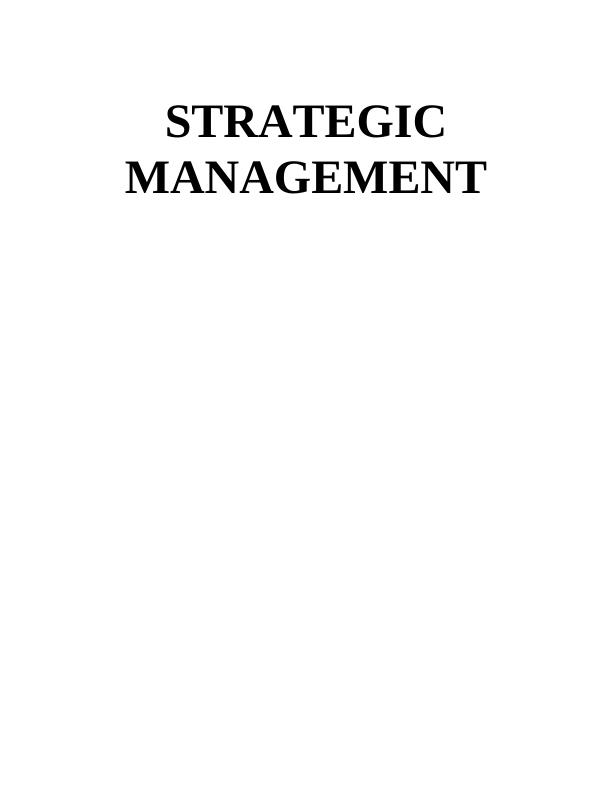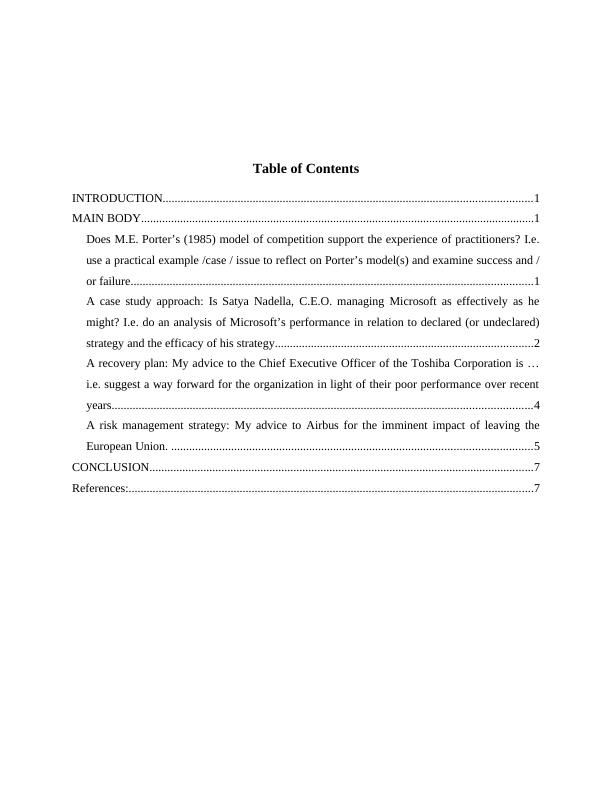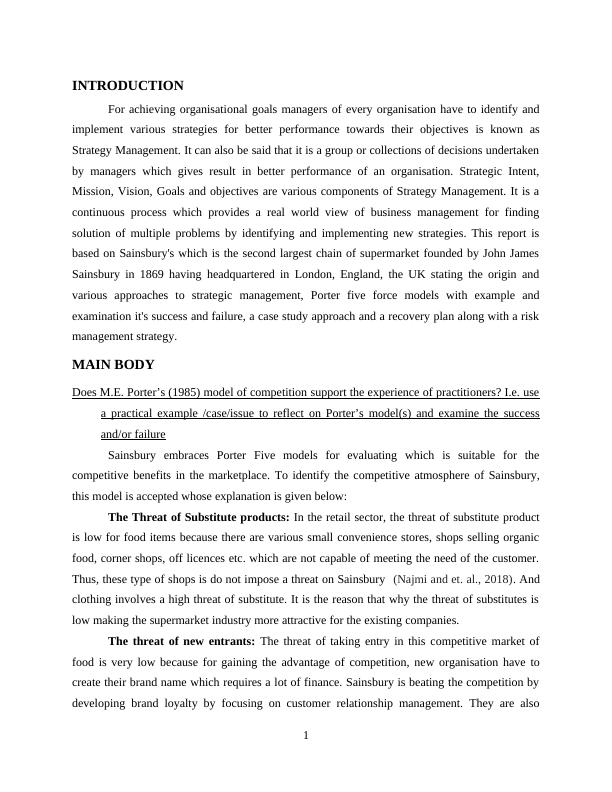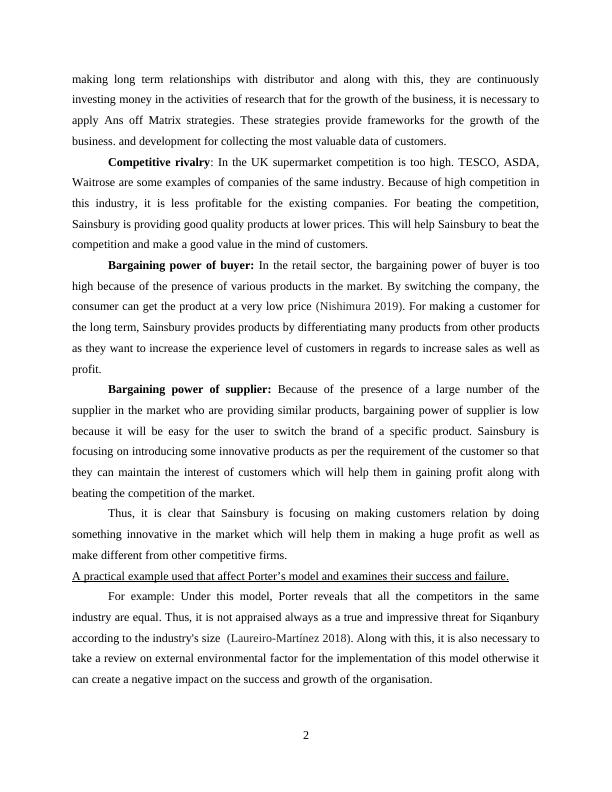Strategic Management: Sainsbury's Case Study
11 Pages3841 Words73 Views
Added on 2022-12-17
About This Document
This report explores strategic management in Sainsbury's, including an analysis of Porter's model of competition, a case study on Microsoft's strategy, and a recovery plan for Toshiba Corporation. It also discusses risk management strategies and their impact on the imminent departure of the European Union.
Strategic Management: Sainsbury's Case Study
Added on 2022-12-17
ShareRelated Documents
STRATEGIC
MANAGEMENT
MANAGEMENT

Table of Contents
INTRODUCTION...........................................................................................................................1
MAIN BODY...................................................................................................................................1
Does M.E. Porter’s (1985) model of competition support the experience of practitioners? I.e.
use a practical example /case / issue to reflect on Porter’s model(s) and examine success and /
or failure......................................................................................................................................1
A case study approach: Is Satya Nadella, C.E.O. managing Microsoft as effectively as he
might? I.e. do an analysis of Microsoft’s performance in relation to declared (or undeclared)
strategy and the efficacy of his strategy......................................................................................2
A recovery plan: My advice to the Chief Executive Officer of the Toshiba Corporation is ...
i.e. suggest a way forward for the organization in light of their poor performance over recent
years............................................................................................................................................4
A risk management strategy: My advice to Airbus for the imminent impact of leaving the
European Union. ........................................................................................................................5
CONCLUSION................................................................................................................................7
References:.......................................................................................................................................7
INTRODUCTION...........................................................................................................................1
MAIN BODY...................................................................................................................................1
Does M.E. Porter’s (1985) model of competition support the experience of practitioners? I.e.
use a practical example /case / issue to reflect on Porter’s model(s) and examine success and /
or failure......................................................................................................................................1
A case study approach: Is Satya Nadella, C.E.O. managing Microsoft as effectively as he
might? I.e. do an analysis of Microsoft’s performance in relation to declared (or undeclared)
strategy and the efficacy of his strategy......................................................................................2
A recovery plan: My advice to the Chief Executive Officer of the Toshiba Corporation is ...
i.e. suggest a way forward for the organization in light of their poor performance over recent
years............................................................................................................................................4
A risk management strategy: My advice to Airbus for the imminent impact of leaving the
European Union. ........................................................................................................................5
CONCLUSION................................................................................................................................7
References:.......................................................................................................................................7

INTRODUCTION
For achieving organisational goals managers of every organisation have to identify and
implement various strategies for better performance towards their objectives is known as
Strategy Management. It can also be said that it is a group or collections of decisions undertaken
by managers which gives result in better performance of an organisation. Strategic Intent,
Mission, Vision, Goals and objectives are various components of Strategy Management. It is a
continuous process which provides a real world view of business management for finding
solution of multiple problems by identifying and implementing new strategies. This report is
based on Sainsbury's which is the second largest chain of supermarket founded by John James
Sainsbury in 1869 having headquartered in London, England, the UK stating the origin and
various approaches to strategic management, Porter five force models with example and
examination it's success and failure, a case study approach and a recovery plan along with a risk
management strategy.
MAIN BODY
Does M.E. Porter’s (1985) model of competition support the experience of practitioners? I.e. use
a practical example /case/issue to reflect on Porter’s model(s) and examine the success
and/or failure
Sainsbury embraces Porter Five models for evaluating which is suitable for the
competitive benefits in the marketplace. To identify the competitive atmosphere of Sainsbury,
this model is accepted whose explanation is given below:
The Threat of Substitute products: In the retail sector, the threat of substitute product
is low for food items because there are various small convenience stores, shops selling organic
food, corner shops, off licences etc. which are not capable of meeting the need of the customer.
Thus, these type of shops is do not impose a threat on Sainsbury (Najmi and et. al., 2018). And
clothing involves a high threat of substitute. It is the reason that why the threat of substitutes is
low making the supermarket industry more attractive for the existing companies.
The threat of new entrants: The threat of taking entry in this competitive market of
food is very low because for gaining the advantage of competition, new organisation have to
create their brand name which requires a lot of finance. Sainsbury is beating the competition by
developing brand loyalty by focusing on customer relationship management. They are also
1
For achieving organisational goals managers of every organisation have to identify and
implement various strategies for better performance towards their objectives is known as
Strategy Management. It can also be said that it is a group or collections of decisions undertaken
by managers which gives result in better performance of an organisation. Strategic Intent,
Mission, Vision, Goals and objectives are various components of Strategy Management. It is a
continuous process which provides a real world view of business management for finding
solution of multiple problems by identifying and implementing new strategies. This report is
based on Sainsbury's which is the second largest chain of supermarket founded by John James
Sainsbury in 1869 having headquartered in London, England, the UK stating the origin and
various approaches to strategic management, Porter five force models with example and
examination it's success and failure, a case study approach and a recovery plan along with a risk
management strategy.
MAIN BODY
Does M.E. Porter’s (1985) model of competition support the experience of practitioners? I.e. use
a practical example /case/issue to reflect on Porter’s model(s) and examine the success
and/or failure
Sainsbury embraces Porter Five models for evaluating which is suitable for the
competitive benefits in the marketplace. To identify the competitive atmosphere of Sainsbury,
this model is accepted whose explanation is given below:
The Threat of Substitute products: In the retail sector, the threat of substitute product
is low for food items because there are various small convenience stores, shops selling organic
food, corner shops, off licences etc. which are not capable of meeting the need of the customer.
Thus, these type of shops is do not impose a threat on Sainsbury (Najmi and et. al., 2018). And
clothing involves a high threat of substitute. It is the reason that why the threat of substitutes is
low making the supermarket industry more attractive for the existing companies.
The threat of new entrants: The threat of taking entry in this competitive market of
food is very low because for gaining the advantage of competition, new organisation have to
create their brand name which requires a lot of finance. Sainsbury is beating the competition by
developing brand loyalty by focusing on customer relationship management. They are also
1

making long term relationships with distributor and along with this, they are continuously
investing money in the activities of research that for the growth of the business, it is necessary to
apply Ans off Matrix strategies. These strategies provide frameworks for the growth of the
business. and development for collecting the most valuable data of customers.
Competitive rivalry: In the UK supermarket competition is too high. TESCO, ASDA,
Waitrose are some examples of companies of the same industry. Because of high competition in
this industry, it is less profitable for the existing companies. For beating the competition,
Sainsbury is providing good quality products at lower prices. This will help Sainsbury to beat the
competition and make a good value in the mind of customers.
Bargaining power of buyer: In the retail sector, the bargaining power of buyer is too
high because of the presence of various products in the market. By switching the company, the
consumer can get the product at a very low price (Nishimura 2019). For making a customer for
the long term, Sainsbury provides products by differentiating many products from other products
as they want to increase the experience level of customers in regards to increase sales as well as
profit.
Bargaining power of supplier: Because of the presence of a large number of the
supplier in the market who are providing similar products, bargaining power of supplier is low
because it will be easy for the user to switch the brand of a specific product. Sainsbury is
focusing on introducing some innovative products as per the requirement of the customer so that
they can maintain the interest of customers which will help them in gaining profit along with
beating the competition of the market.
Thus, it is clear that Sainsbury is focusing on making customers relation by doing
something innovative in the market which will help them in making a huge profit as well as
make different from other competitive firms.
A practical example used that affect Porter’s model and examines their success and failure.
For example: Under this model, Porter reveals that all the competitors in the same
industry are equal. Thus, it is not appraised always as a true and impressive threat for Siqanbury
according to the industry's size (Laureiro‐Martínez 2018). Along with this, it is also necessary to
take a review on external environmental factor for the implementation of this model otherwise it
can create a negative impact on the success and growth of the organisation.
2
investing money in the activities of research that for the growth of the business, it is necessary to
apply Ans off Matrix strategies. These strategies provide frameworks for the growth of the
business. and development for collecting the most valuable data of customers.
Competitive rivalry: In the UK supermarket competition is too high. TESCO, ASDA,
Waitrose are some examples of companies of the same industry. Because of high competition in
this industry, it is less profitable for the existing companies. For beating the competition,
Sainsbury is providing good quality products at lower prices. This will help Sainsbury to beat the
competition and make a good value in the mind of customers.
Bargaining power of buyer: In the retail sector, the bargaining power of buyer is too
high because of the presence of various products in the market. By switching the company, the
consumer can get the product at a very low price (Nishimura 2019). For making a customer for
the long term, Sainsbury provides products by differentiating many products from other products
as they want to increase the experience level of customers in regards to increase sales as well as
profit.
Bargaining power of supplier: Because of the presence of a large number of the
supplier in the market who are providing similar products, bargaining power of supplier is low
because it will be easy for the user to switch the brand of a specific product. Sainsbury is
focusing on introducing some innovative products as per the requirement of the customer so that
they can maintain the interest of customers which will help them in gaining profit along with
beating the competition of the market.
Thus, it is clear that Sainsbury is focusing on making customers relation by doing
something innovative in the market which will help them in making a huge profit as well as
make different from other competitive firms.
A practical example used that affect Porter’s model and examines their success and failure.
For example: Under this model, Porter reveals that all the competitors in the same
industry are equal. Thus, it is not appraised always as a true and impressive threat for Siqanbury
according to the industry's size (Laureiro‐Martínez 2018). Along with this, it is also necessary to
take a review on external environmental factor for the implementation of this model otherwise it
can create a negative impact on the success and growth of the organisation.
2

End of preview
Want to access all the pages? Upload your documents or become a member.
Related Documents
Strategic Analysis of TESCOlg...
|12
|4006
|22
Strategic Management: Theory, Practice, and Case Studylg...
|13
|3975
|50
Strategic Management: Porter's Model, Case Study, Recovery Plan, Risk Managementlg...
|11
|3848
|100
Strategic Management: Porter's Five Forces and Value Chain Model Analysis of Sainsburylg...
|12
|3796
|208
Strategic Management: Tesco's Competition and Recovery Planlg...
|12
|3687
|55
Strategic Management: Theory, Practice, and Case Study Approachlg...
|10
|3879
|95
